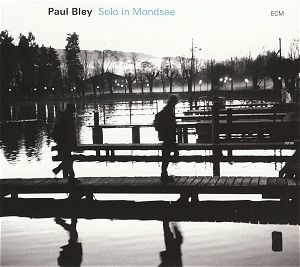Released in time for Paul Bley’s 75th birthday
in the autumn of 2007, Solo in Mondsee
is the first Bley solo piano album on ECM
in 35 years. Paul Bley was born in Montreal
in 1932. While still in his twenties he played
with Charlie Parker, Lester Young, Coleman
Hawkins, Ben Webster, Chet Baker, and many
others. At 21, he made his first album as
a leader for Charles Mingus’s Debut label,
with Mingus himself on bass and Art Blakey
on drums.
Briefly based in California in the late 1950s,
his quintet of 1958 helped introduce the talents
of Ornette Coleman, Don Cherry, Charlie Haden
and Billy Higgins to the jazz world. In the
early 1960s, as a member of the Jimmy Giuffre
Trio and in his own groups, Bley brought chamber
music clarity into the new domain of free
jazz. A prolific recording artist, Bley was
amongst the first artists to appear on ECM
with "Paul Bley with Gary Peacock"
(recorded 1964 and 1968) and "Ballads"
(recorded 1967) – those were issued as ECM
1003 and ECM 1010. In 1972 Eicher recorded
Bley solo on the enduring classic "Open,
To Love" (ECM 1023), to which this new
solo album might be seen as a much belated
sequel.
Manfred Eicher had already recorded András
Schiff playing Schubert fantasies on the superb
Bösendorfer Imperial Grand in Mondsee,
Austria (ECM New Series 1699), and decided
to invite Bley to the same location. The choice
on instrument has to be a big influence on
any improvised session, and the more rounded
sound and greater sustain that a Bösendorfer
has over the usually brighter sounding modern
Steinway suits Bley’s sense of space and timelessness
to the ground. Bley doesn’t overwork the tonsil-rattling
bass that this piano has, but in this superb
recording you can sense him exploring, roaming
the registers and revelling in the instrument’s
expressive potential.
The Mondsee Variations are less variations
in the classical sense – based around a theme
or musical idea, they are more a set of musical
shapes fitting around a mood; filled with
musical surprises and unexpected changes of
direction. If your are hunting for references
to describe Paul Bley’s style then for me
at least, it is a relief not to have to say
he owes anything to Keith Jarrett – the fact
being that the direction of any influence
is the other way around. Bley is best known
for his myriad collaborations and work in
the field of electronic music making, and
I find his solo pianism hard to categorise.
Thinking of some other favourites, he is in
any case far removed from the down-to-earth
brilliance of Dave McKenna, or the more Gallic
romanticism of Michel Petrucciani – yes, if
you like Keith Jarrett, at least at when he’s
not being obscure and pretentious, you should
like this. Bley shares that right-hand melodic
facility which is the magic implement of all
great jazz pianists. The harmonies are sometimes
suggested or lushly present, but they always
feel ‘right’. This is not ‘free jazz’ improvisation
in the sense that it sails in any way close
to aversion-therapy abstract musicianship,
and many tracts of this album could almost
withstand misuse as background music if you
were so inclined, although the higher-number
variations do become a little more demanding.
There isn’t much in the way of overt funkiness:
Paul Bley’s groove lies several layers deeper
than the immediately accessible epidermis,
but seek and ye shall find. Listen properly,
and become acquainted with this pianist’s
individuality of idiom and style, and you
may find that this album’s 55 minutes have
passed in a kind of trance. You won’t get
those 55 minutes back, but time was rarely
spent with greater reward.
Dominy Clements
